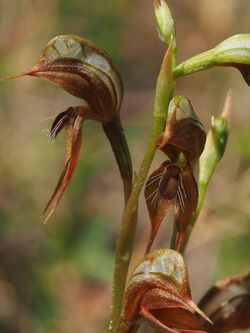Biology:Pterostylis praetermissa
| Mount Kaputar rustyhood | |
|---|---|

| |
| Pterostylis praetermissa in the Mount Kaputar National Park | |
| Scientific classification | |
| Kingdom: | Plantae |
| Clade: | Tracheophytes |
| Clade: | Angiosperms |
| Clade: | Monocots |
| Order: | Asparagales |
| Family: | Orchidaceae |
| Subfamily: | Orchidoideae |
| Tribe: | Cranichideae |
| Genus: | Pterostylis |
| Species: | P. praetermissa
|
| Binomial name | |
| Pterostylis praetermissa | |
| Synonyms[1] | |
|
Oligochaetochilus praetermissus (D.L.Jones & M.A.Clem.) Szlach. | |
Pterostylis praetermissa, commonly known as the Mount Kaputar rustyhood is a plant in the orchid family Orchidaceae and is endemic to New South Wales. It has a rosette of leaves and up to nine relatively small greenish and reddish-brown flowers with transparent "windows" and a reddish-brown, insect-like labellum.
Description
Pterostylis praetermissa is a terrestrial, perennial, deciduous, herb with an underground tuber. It has a rosette of between five and eight leaves, each leaf 20–35 mm (0.8–1 in) long and 8–17 mm (0.3–0.7 in) wide. Flowering plants have a rosette at the base and up to eight greenish and reddish-brown flowers with transparent panels and which are 20–25 mm (0.8–1 in) long and 4–5 mm (0.16–0.20 in) wide on a flowering stem 150–250 mm (6–10 in) tall. There are between two and five stem leaves with their bases loosely wrapped around the flowering stem. The dorsal sepal and petals form a hood called the "galea" over the column with the dorsal sepal having a narrow point 2–3 mm (0.08–0.1 in) long. The lateral sepals turn downwards, about the same width as the galea and have thread-like tips 5–6 mm (0.20–0.24 in) long. The labellum is almost flat, reddish-brown, fleshy and insect-like, about 5 mm (0.2 in) long and 2 mm (0.08 in) wide. The "head" end has many short hairs and there are between twelve and fifteen longer hairs on each side of the body. Flowering occurs from September to October.[2][3]
Taxonomy and naming
Pterostylis praetermissa was first formally described in 1989 by David Jones and Mark Clements from a specimen collected from near the Mount Kaputar National Park and published the description in Australian Orchid Research.[1] The specific epithet (praetermissa) is derived from the Latin words praeter meaning "beyond", "past" or "more than"[4]:629 and missus meaning "sent".[4]:527
Distribution and habitat
The Mount Kaputar rustyhood occurs in isolated populations on forest slopes and rocky ridges between Mount Kaputar and Barrington Tops.[2][3]
References
- ↑ Jump up to: 1.0 1.1 1.2 "Pterostylis praetermissa". APNI. https://id.biodiversity.org.au/instance/apni/488296. Retrieved 5 July 2017.
- ↑ Jump up to: 2.0 2.1 Jones, David L. (2006). A complete guide to native orchids of Australia including the island territories. Frenchs Forest, N.S.W.: New Holland. p. 323. ISBN 978-1877069123.
- ↑ Jump up to: 3.0 3.1 Jones, David L.. "Pterostylis praetermissa". Royal Botanic Garden Sydney: plantnet. http://plantnet.rbgsyd.nsw.gov.au/cgi-bin/NSWfl.pl?page=nswfl&lvl=sp&name=Pterostylis~praetermissa. Retrieved 5 July 2017.
- ↑ Jump up to: 4.0 4.1 Brown, Roland Wilbur (1956). The Composition of Scientific Words. Washington, D.C.: Smithsonian Institution Press.
External links
Wikidata ☰ Q15493553 entry
 |

